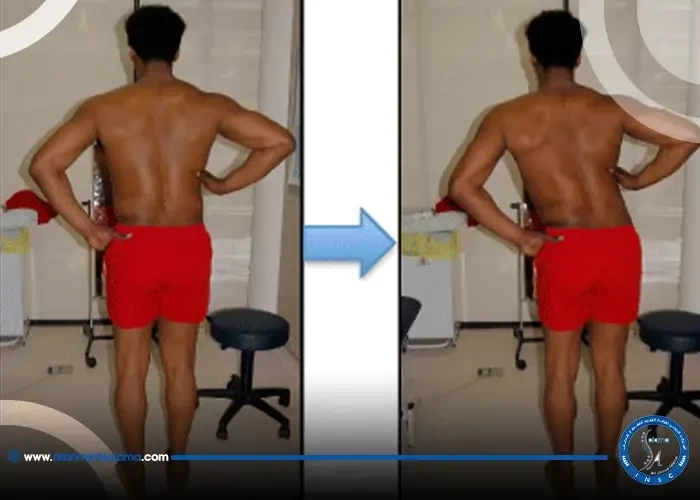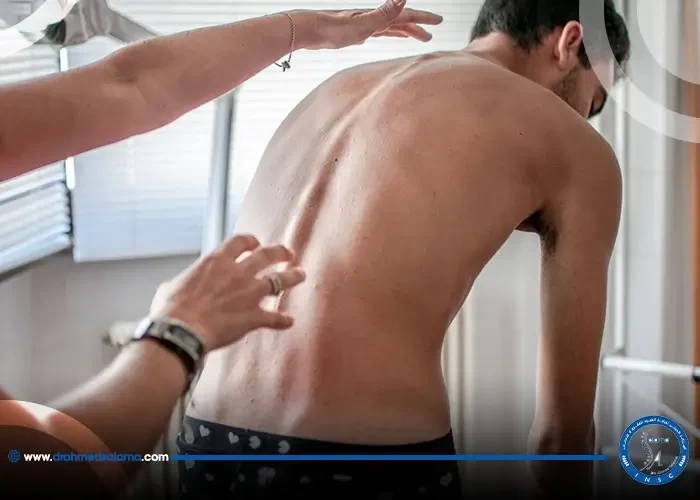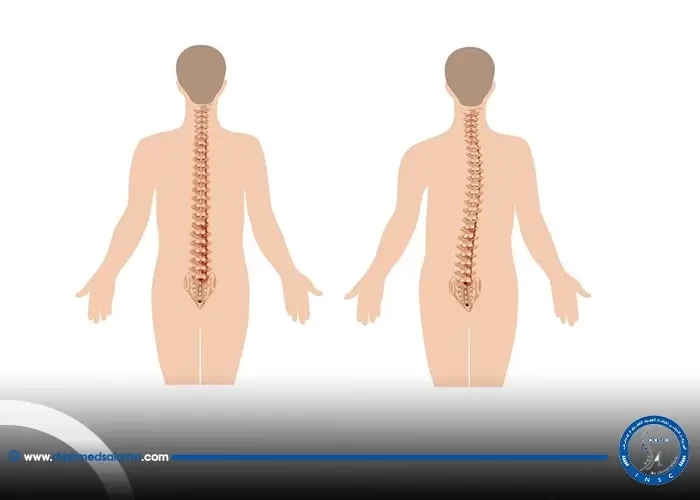Nasr City, 52 El Tayaran Street, in front of the Health Insurance Hospital

Lower back pain above the buttocks: a comprehensive guide to causes and treatment

Lower back pain above the buttocks is one of the most common health problems that can hinder your daily mobility and affect your quality of life, especially if the pain is severe in the lower back, extends to the legs, or is accompanied by a feeling of tension or numbness. Although some may underestimate these symptoms, ignoring treatment for lower back pain can lead to serious complications for the spine and surrounding muscles.
In this article, we will learn the most important information about lower back pain above the buttocks in detail, including its causes and associated symptoms. We will also discuss ways to treat lower back pain above the buttocks. All this with Dr. Ahmed Ibrahim Salama, a consultant neurosurgeon and spine surgeon. Just keep reading.
Lower Back Pain Above the Buttocks
Lower back pain above the buttocks is a disturbing symptom that many people may suffer from. It often appears as a result of problems with the muscles, ligaments, or vertebrae of the spine. It may also be associated with prolonged sitting or excessive physical exertion.
Neglecting to treat lower back pain can worsen the pain over time and limit your ability to move normally, especially if the cause is related to nerve or lumbar vertebrae problems such as inflammation or a herniated disc.
Therefore, if you suffer from recurrent or persistent lower back pain above the buttocks, do not hesitate to schedule a consultation with Dr. Ahmed Ibrahim Salama, a neurosurgery consultant, to determine the cause and develop an effective treatment plan tailored to your condition. This will help you regain your comfort and return to your daily life pain-free.
Causes of Lower Back Pain Above the Buttocks
The causes of lower back pain are numerous and vary from person to person, ranging from simple problems that can be treated with rest and physical therapy to more complex ones that require specialized medical intervention. Understanding the causes is an essential step in choosing the appropriate treatment and avoiding more serious complications. The most prominent causes of lower back pain include:
Stretched or strained muscles and ligaments resulting from lifting heavy weights, sudden movements, or sitting incorrectly for long periods.
Joint inflammation, such as osteoarthritis or ankylosing spondylitis, causes chronic stiffness and pain.
A herniated disc, which compresses nerves and causes pain radiating to the buttocks or legs.
Narrowing of the spinal canal, which compresses nerves and causes pain and limited movement.
Spondyloarthritis, which causes stiffness and pain that worsens with decreased movement.
Osteoporosis, which weakens the vertebrae and makes them susceptible to fractures.
Tumors in the spine or pelvis, which may compress nerves or bones.
Don't let lower back pain above the buttocks affect your quality of life and worsen over time. Book your consultation with Dr. Ahmed Ibrahim Salama now to learn more about getting an accurate diagnosis and a treatment plan tailored to your condition.
Symptoms of Severe Lower Back Pain
The symptoms of lower back pain above the buttocks vary from person to person depending on the cause and duration of the injury. In some cases, the pain may extend to affect the ability to sit or move normally. The most prominent symptoms that may accompany severe lower back pain include:
Difficulty moving, bending, or sitting for long periods.
Back muscle spasms or stiffness.
Pain extending to the buttocks or legs (sciatica).
Numbness or tingling in the legs or feet.
Muscle weakness or difficulty lifting objects.
Sometimes, loss of bladder or bowel control in severe cases.
If you experience any of these symptoms, don't wait for the condition to worsen. Book a consultation with Dr. Ahmed Ibrahim Salama now to accurately diagnose the cause and develop an effective treatment plan that suits you and helps you permanently eliminate lower back pain above the buttocks.
Treatment for Lower Back Pain Above the Buttocks
Treatment for lower back pain above the buttocks depends on accurately identifying the cause. Treatment methods vary from person to person depending on the severity and nature of the pain. Treatment aims to alleviate symptoms and improve recovery and quality of life. The most prominent treatment methods for lower back pain above the buttocks include:
Conservative Treatment
In mild cases, lower back pain above the buttocks may respond to uncomplicated treatment steps based on rest and avoiding activities that aggravate pain, while maintaining a reasonable level of movement to prevent muscle stiffness. It is also recommended to apply cold or warm compresses to the painful area, get adequate sleep, and change sitting and standing positions frequently throughout the day. Topical creams or ointments can also be used to relieve pain and improve circulation to the affected area.
Medication
Depending on the severity and cause of the condition, your doctor may recommend a combination of medications to relieve pain and reduce inflammation. These medications include:
Common pain relievers such as paracetamol to relieve pain.
Nonsteroidal anti-inflammatory drugs such as ibuprofen or naproxen to reduce inflammation and pain.
Muscle relaxants to reduce muscle spasms associated with lower back pain above the buttocks.
Stronger medications for nerve pain, such as some antidepressants or antiepileptic drugs, are used for sciatica or affected nerves.
Physiotherapy
In some cases, physical therapy sessions with a specialized physical therapist may be an effective option for pain relief and improved mobility. This includes:
Stretching and strengthening exercises for the muscles that support the spine and reduce pressure on the vertebrae.
Heat or cold therapy to relieve pain and reduce muscle spasms.
Massage sessions to improve blood flow and relieve muscle tension.
Ultrasound therapy or electrical stimulation to stimulate healing and reduce inflammation.
Teaching correct posture while sitting or lifting to avoid recurrence of injury.
Modern Treatment Techniques Without Surgery
In cases that do not respond to medication or physical therapy, advanced techniques can be used to relieve lower back pain above the buttocks without the need for surgical intervention. These include:
Local injection of cortisone or local anesthetic to reduce inflammation and pain directly in the affected area.
Radiofrequency to disrupt the sensory portion of the nerves responsible for transmitting pain signals to the brain.
Surgical Treatment
Doctors resort to surgical treatment only if all other treatments have failed or there is a clear cause requiring surgical intervention, such as severe nerve compression or a clear structural deformity. The most prominent surgical procedures include:
Discectomy: Removing the herniated portion of the disc to relieve pressure on the nerves.
Spinal Fusion: Stabilizing two or more vertebrae to prevent painful movement and increase stability.
Laminectomy: Removing part of the vertebral bone to relieve pressure on the spinal cord or nerves.
Minimally invasive surgery: A minimally invasive surgical procedure that aims to minimize damage to surrounding tissues and speed recovery.
To achieve the best results in treating lower back pain above the buttocks, don't hesitate to obtain an accurate diagnosis that pinpoints the exact cause of your pain, enabling you to choose the appropriate treatment for your condition. Contact Dr. Ahmed Ibrahim Salama now to benefit from his expertise in developing a comprehensive treatment plan that will restore your comfort and quality of life.
The Best Doctor for Lower Back Pain
When it comes to finding effective treatments for lower back pain, choosing a doctor who combines extensive scientific experience with advanced practical skills is essential to ensuring accurate diagnosis and effective treatment. Dr. Ahmed Ibrahim Salama, a consultant neurosurgeon and spine surgeon, is one of the most prominent specialists in treating lower back pain, above the buttocks, and the spine in general. He has a proven track record and extensive experience in treating both complex and simple spine conditions.
The most important features and reasons that make Dr. Ahmed Ibrahim Salama the first choice for many patients include:
A consultant neurosurgeon and spine surgeon with advanced expertise in pediatric and adult surgery.
He is a fellow of the American Spinal Deformity Society and a member of the Egyptian, European, Swiss, and American Societies of Neurosurgeons and Spine Surgeons. He holds a doctorate in 3D reconstruction technology for spinal deformities, reflecting his distinguished scientific standing and extensive experience in creating advanced treatment solutions that achieve the best results for patients.
He offers individualized treatment plans tailored to each case after a thorough diagnosis using the latest technologies.
He relies on the latest diagnostic and treatment techniques to ensure the best results.
He is keen to minimize surgical interventions as much as possible.
He provides close monitoring of the patient's condition to ensure a full recovery.
In conclusion, lower back pain above the buttocks is a common condition that can progress rapidly if neglected, negatively impacting mobility and quality of life. Therefore, early diagnosis and appropriate treatment are essential steps to ensure you can resume your normal life and avoid complications that may affect the spine and nerves. Because choosing an experienced doctor makes a significant difference in the speed of recovery and the effectiveness of the results, don't hesitate to contact Dr. Ahmed Ibrahim Salama, a consultant neurosurgeon and spine surgeon, to benefit from his experience and modern techniques in developing a comprehensive treatment plan that will restore your comfort and ability to move with confidence and safety.
How do I know if my lower back pain is serious?
Lower back pain becomes serious if it is severe and persists for several weeks, or if it is accompanied by symptoms such as numbness or weakness in the legs, or difficulty controlling urine or bowel movements. These signs may indicate serious nerve or spinal problems that require immediate medical intervention.
What are the causes of coccyx pain in the lower back above the buttocks?
The causes of coccyx pain vary, from direct injuries resulting from falls or prolonged incorrect sitting, to arthritis, muscle strain, or medical conditions such as a herniated disc and spinal stenosis in the lower back.






